With its broad range of types, the mandolin serves as a versatile instrument across various musical genres. Recognized for its bright, resonant tone and comfortable playability, the mandolin can express a wide spectrum of artistic expression.
This article will delve into the detailing of various types of mandolins, exploring the sheer diversity of available styles—from the iconic Neapolitan and American flatback mandolins to the special mandola.
The aim is to enhance your understanding of these unique instruments, empowering musicians to make an informed choice in their mandolin journey.
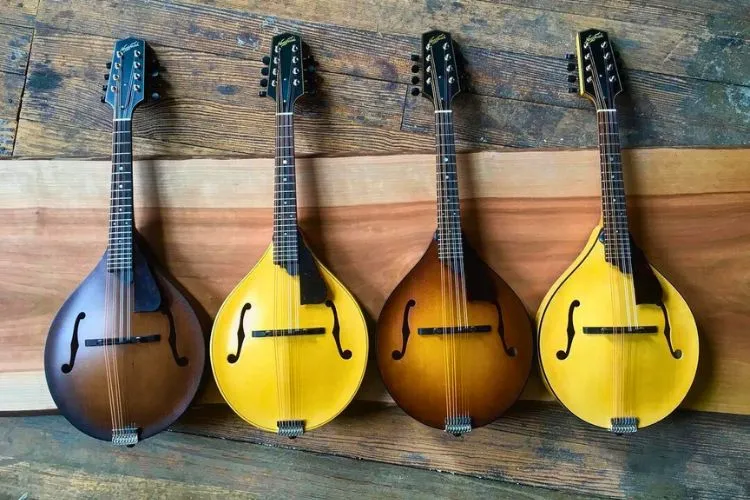
Contents
🎶Types of Mandolins
Mandolins, originating from Italy and evolving globally, have diversified into several types. Neapolitan, or ‘Bowlback’ Mandolins, known for their rounded back, is a staple in Italian classical and folk tunes.
With its flat-back construction, the American Flatback Mandolins offers a practical approach to various musical genres. Among them, A-style and F-style are the most prominent.
Carved Top Mandolins featuring an intricately arched soundboard provide a distinctive resonance.
Lastly, by varying in tuning and range, the Mandola and other mandolin variants cater to orchestras and folk music, enriching the melodic tapestry of compositions.
Neapolitan (Bowlback) Mandolins
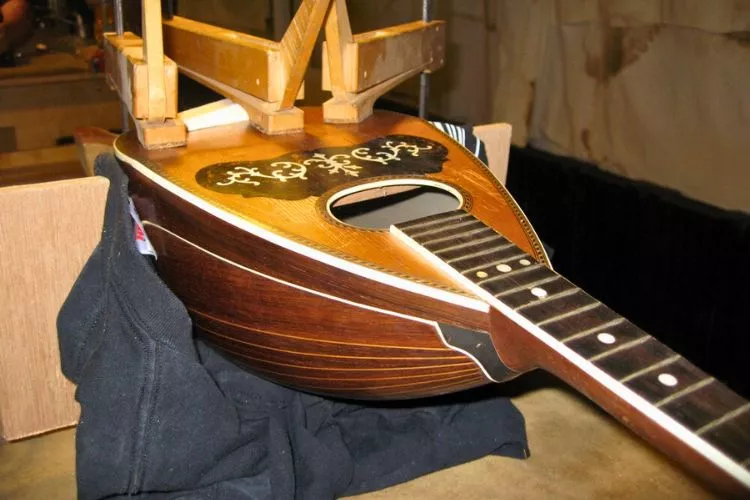
- History and origin: Neapolitan mandolins, often called bowl-back mandolins, originated in Naples, Italy, in the 18th century. They are an evolution of the ancient lute and boast a long, rich history of captivating audiences with their distinctive sound.
- Unique features and construction details: The key characteristic of Neapolitan mandolins is their rounded back, which resembles a bowl, hence the name “bowl back.” This design feature contributes to their unique tonal qualities. Other defining features include a short neck, ornate sound hole, and typically gut strings (although modern variations use metal strings).
- The type of music and tradition it’s used in Neapolitan mandolins are deeply rooted in Italian folk and classical music. They lend themselves well to intricate, expressive playing styles and have been prominent in opera music, European classical compositions, and various traditional music forms.
- Famous Neapolitan mandolin players: Notable Neapolitan mandolin players include Carlo Munier, Raffaele Calace, and Silvio Ranieri, all of whom significantly contributed to the mandolin’s repertoire and technique.
The American Flatback Mandolins
- Overview and historical context: American flatback mandolins emerged in the United States during the late 19th and early 20th centuries. They were a response to the growing desire for a louder, more projection-capable mandolin to match the evolving sound of American music. The flatback design offers more volume and sustain than Neapolitan mandolins.
- Features and sound qualities: Distinct from the Neapolitan style, American flatback mandolins have a flat back, as their name suggests. They typically feature arched tops, f-holes, and elevated fingerboards. They suit various music styles, including bluegrass, folk, jazz, and country.
- Different models: A-style and F-style Mandolins: The two predominant models of American flatback mandolins are the A-style and F-style:
- A-style mandolins are characterized by their teardrop-shaped body and symmetrical design. They are usually more affordable and are popular among beginners and intermediate players.
- F-style mandolins feature a scrolled body and an asymmetrical design, making them easily recognizable. They are typically more expensive due to their intricate craftsmanship and are favored by professional players.
- Performance comparison: A-style and F-style mandolins differ mainly in appearance and price. There is no significant difference in sound quality between the two styles.
- Famous American flatback mandolin musicians: Pioneers of American flatback mandolins include Bill Monroe, Ricky Skaggs, and Chris Thile, whose remarkable playing styles have redefined the instrument in modern music.
The Carved Top Mandolins
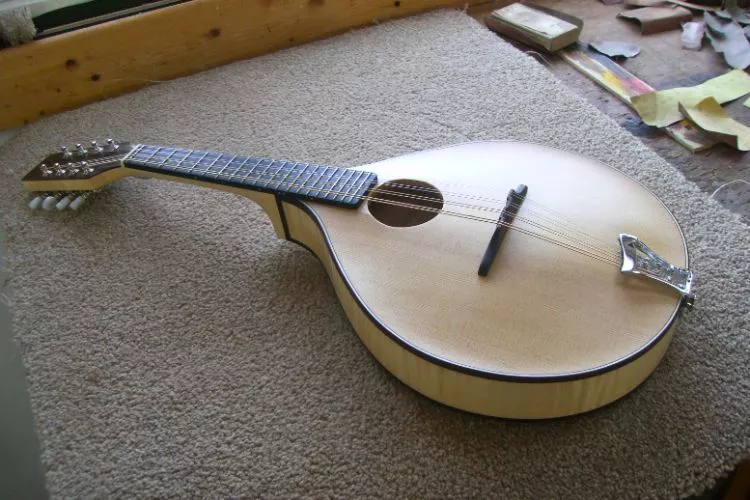
- Brief history: Carved top mandolins originated in Europe during the 20th century. While similar in design to American flatback mandolins, they distinguish themselves by their carved soundboards and have impacted various music styles.
- Key features and typical uses: Carved top mandolins have a unique appearance, with fully carved solid wood tops. This quality brings out enhanced resonance and harmonic complexity. They can be found in diverse styles of music, such as folk, world, and classical.
- Famous carved-top mandolin artists: Some renowned players are Mike Marshall, David Grisman, and Paul Glasse, who have earned admiration for incorporating a wide range of styles into their playing.
Mandola and Other Mandolin Variants
- Brief description and history: The mandola is a close relative of the mandolin, sometimes called the tenor mandola or alto mandolin. Other mandolin variants include mandocello, mandobass, and octave mandolin. These instruments differ in construction details, tuning, and range, expanding the possibilities for mandolin-family musicians.
- Differences in tuning and range compared to the standard mandolin: Mandolas are tuned to a fifth lower than mandolins, which results in a more mellow and richer sound. Mandolins are usually tuned GDAE, while mandolas are tuned CGDA.
- Role in orchestras and folk music: Mandola and other mandolin variants often play a prominent role in orchestras, chamber music, and traditional folk ensembles. The diverse range of sizes and voices adds versatility and depth to the overall sound.
Italian Mandolins
- Brief introduction and history: Italian mandolins have a storied history dating back to the 18th century. Evolving from instruments like the lute, Italian mandolins have since become an emblem of the country’s musical heritage.
- Signature marks characteristic of Italian style: Italian mandolins typically have a bowl-back design and intricate craftsmanship. A key characteristic is their warm, expressive sound, associated with classical and traditional Italian music. Their playing techniques often include tremolo and rhythmic strumming patterns.
Irish Mandolins
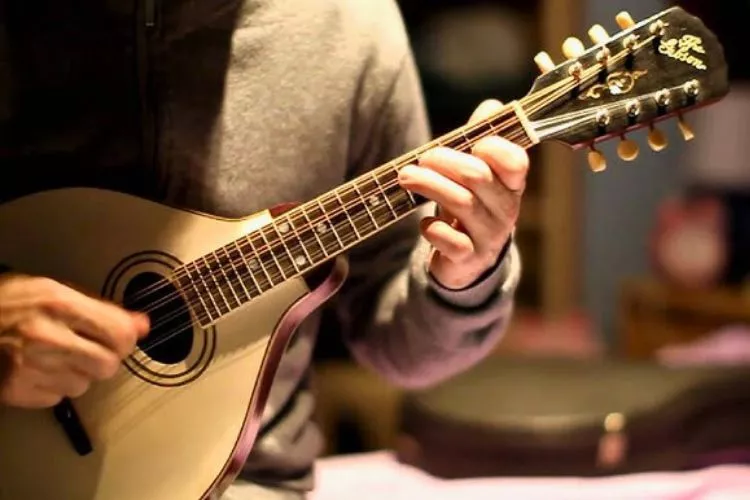
- Overview and notable features: Irish mandolins have made a lasting impact despite being relatively recent additions to Irish traditional music. They share similarities with their American counterparts but often feature shorter scales.
- Their flat back design provides a bright sound, perfect for cutting through lively sessions or blending harmoniously with other instruments.
- Irish mandolin’s place in Celtic music: The mandolin has found its place in Irish traditional music, accompanying fiddles, flutes, and bodhrans. It serves as a melody and rhythmic instrument, accentuating Celtic tunes’ lively, danceable nature.
Bluegrass Mandolins
- History and contribution to bluegrass music: Bluegrass mandolins, particularly the F-style, gained prominence during the 1940s. They played a significant role in shaping the traditional elements of bluegrass, characterized by fast, syncopated rhythm and driving, intricate melodies.
- Acclaimed bluegrass mandolin players: Notable bluegrass mandolin players include Bill Monroe, often called the “Father of Bluegrass,” for his groundbreaking work in developing the genre. Other influential players are Doyle Lawson, Ricky Skaggs, and Sam Bush, each of whom has contributed to the evolution of bluegrass mandolin styles and techniques.
🎶How to Choose the Right Mandolin?
Choosing the right mandolin involves considering your musical style, budget, and craftsmanship expectations.
Neapolitan mandolins, ideal for classical tunes, are distinct from American flatback mandolins, favored in folk and bluegrass.
Carved-top mandolins cater to diverse music, while instruments like mandolas offer varied tuning and range. Budget is vital, with options available for all levels. Attention to craftsmanship ensures the instrument’s longevity and sound quality.
New mandolins come in perfect condition while used ones provide affordability and matured sound. Recognized manufacturers include Gibson, Eastman, Weber, and Collings. Always trial an instrument before purchasing.
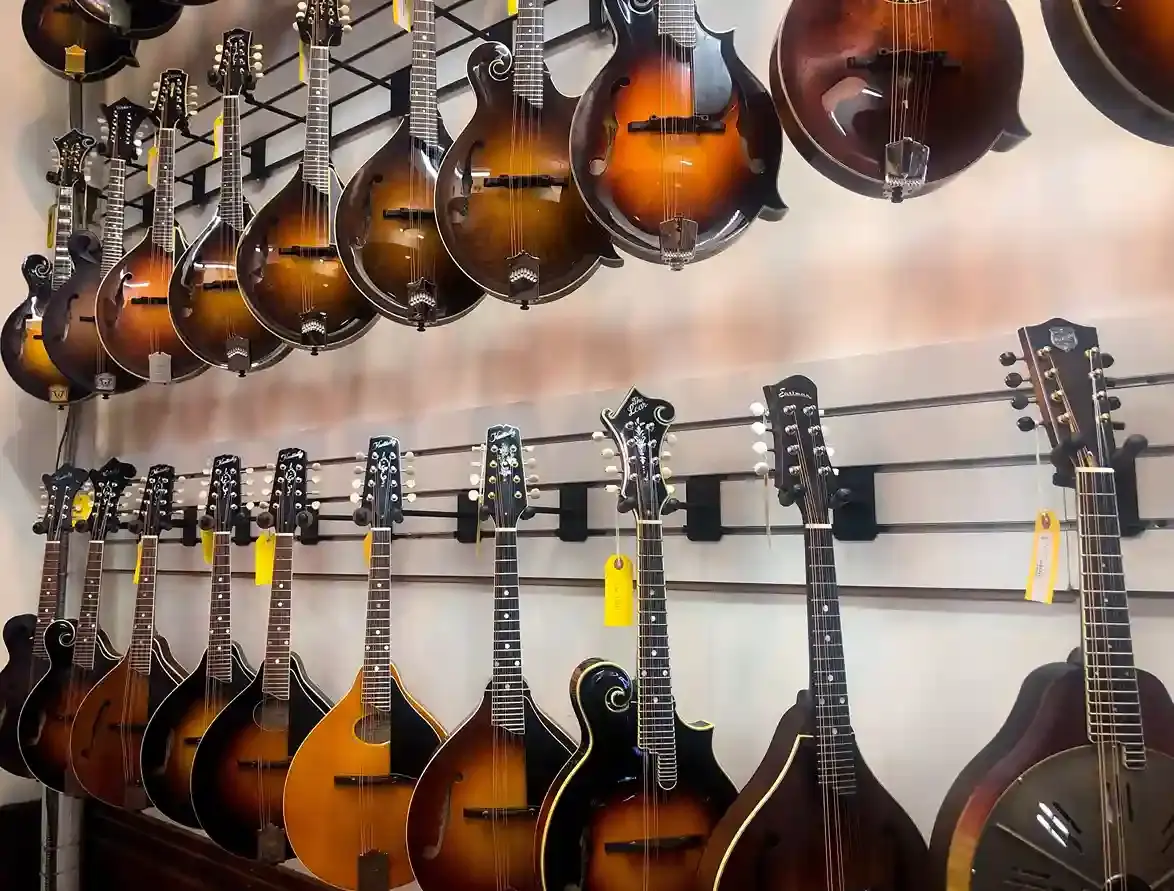
Choosing the Right Mandolin Based on Type
Selecting the right mandolin depends significantly on the music genre you aspire to play and your proficiency level.
Neapolitan mandolins, with their distinctive bowlback design and ornate sound hole, are more suited to classical and traditional Italian tunes. They lend themselves to intricate, expressive playing styles.
American flatback mandolins, including the A-style and F-style variants, have a broader application spectrum, incorporating bluegrass, folk, jazz, and country. Beginners and intermediate players may favor affordable A-style mandolins, while professional players often lean towards the more expensive F-style instruments.
With their unique resonance and harmonic complexity, carved top mandolins cater to diverse styles like folk, world, and classical music.
Other mandolin variants, like the mandola, offer different tunings and ranges, expanding the possibilities for mandolin-family musicians. These could be an excellent exploration for players wanting to venture further into orchestras, chamber music, and traditional folk ensembles.
By understanding these types of mandolins and their associated characteristics, players can make an informed decision on choosing the right mandolin that best resonates with their musical journey.
Basic Requirements
- Musical Style: One of the foremost aspects while selecting a mandolin is the type of music you wish to play. A Neapolitan mandolin might be more suited for classical music and traditional Italian songs, while an F-style mandolin is ideal for bluegrass. If you aim to play Celtic music, an Irish-style mandolin would be perfect.
- Budget: Mandolins vary in price, depending on their type, brand, and materials. An A-style mandolin from a reputable brand could be a reasonably priced starting point for beginners. More advanced players or those looking for a specific sound might explore higher-end models.
- Craftmanship: The quality of craftsmanship and materials greatly affects the instrument’s tone, playability, and longevity. Preferably, choose a mandolin with a solid wood top for better resonance. Pay attention to the feel and smoothness of the neck, the instrument’s fit and finish, and the tuners’ quality.
Tips on buying a new vs. used mandolin
Buying a new mandolin ensures you get a product in pristine condition, possibly with a warranty. However, they could be more expensive and may need a ‘breaking in’ period for the wood to reach its optimum tonal quality.
On the other hand, used mandolins could be an affordable way to get a quality instrument with a matured sound.
However, be sure to check for any signs of damage or excessive wear and, if possible, play it or have an experienced player or luthier review it.
Important Brands/Manufacturers to Know
Several manufacturers have gained a reputation for creating quality mandolins:
- Gibson: Widely esteemed for its F-style and A-style mandolins, Gibson has arguably set the standard for bluegrass and folk players.
- Eastman: This company offers well-crafted mandolins at an affordable price, perfect for beginners and intermediates.
- Weber: Known for their craftsmanship and rich tone, Weber mandolins are favorite among many professional players.
- Collings: Collings mandolins are recognized for their outstanding sound quality, attention to detail, and superior craftsmanship.
What are the different styles of mandolins?
There are several different styles or types of mandolins, each having unique characteristics and suited to various genres of music.

- Classical or Bowl-Back Mandolins: Also known as Neapolitan mandolins, these have a round back made of strips of wood, a distinctive feature that gives them a deep, resonating sound. They are suitable for classical and traditional Italian music.
- Bluegrass Mandolins: These mandolins, predominantly used in bluegrass music, are typically categorized into A-style and F-style. The A-style has a teardrop-shaped body, and the F-style has a fancy scroll and points, contributing to its distinct look.
- Archtop Mandolins: These are usually flat on the top but have a small, arched top design around the sound hole. This mandolin type can offer various tonal qualities and is particularly popular in American styles like folk and bluegrass.
- Flat-backed Mandolins: This group includes the Irish-style or Celtic mandolins, often built similarly to the American flatback but with a shorter scale length. Their bright and loud sound are commonly used in Celtic music.
Different mandolin styles can also feature sound holes, such as “F-holes” or round holes, each affecting the instrument’s tone. It’s important to note that the choice of mandolin style depends heavily on the genre of music and the player’s preference.
🎶Frequently Asked Questions (FAQs)
The most common mandolin is the A-style mandolin, which is named after the teardrop-shaped body it possesses. This mandolin type is prevalent due to its versatility in various music genres and its simple, unornamented design. Additionally, the A-style mandolin is often more reasonably priced, making it an attractive option for beginners and intermediate players in genres like folk, bluegrass, jazz, and country music.
A big mandolin is typically referred to as a mandola. A part of the mandolin family of instruments, the mandola has a larger body and, consequently, a deeper and lower pitch than a standard mandolin. It is tuned similarly to a viola, with the strings tuned to C-G-D-A. Mandolas are used in orchestras, chamber music, and traditional folk ensembles to provide a richer, lower-pitched sound.
The key difference between A and F style mandolins is their body shape and design. An A-style mandolin has a teardrop-shaped body and is relatively simple and unornamented.
In contrast, an F-style mandolin has a more complex design, featuring a scroll near the neck joint and ‘points’ on the lower bout of the body. Both types can be used in the same musical genres, but F-style mandolins are commonly seen as more prestigious, with a higher price tag.
The most popular mandolin is often considered to be the Gibson F-5, designed by Lloyd Loar in 1922. The F-5 quickly gained reputation and popularity among bluegrass musicians, as it combines the elegant F-style design with superior craftsmanship, sound quality, and projection. It has become an iconic instrument within bluegrass music, setting the standard for enthusiasts and professional players.
Conclusion:
The diversity in mandolin types allows musicians to find the perfect instrument to suit their musical preferences and styles.
From the traditional Neapolitan bowl-back and versatile A-style mandolins to the more ornate F-style and lower-pitched mandola, each variant offers unique characteristics, lending itself to specific genres.
By understanding the nuances of these mandolin types, players can make informed decisions to select instruments to enhance their musical journey, enabling them to fully express their artistic capabilities while contributing to the rich tapestry of musical traditions.
